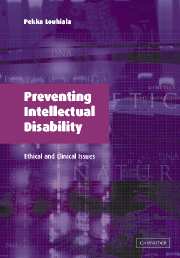Book contents
- Frontmatter
- Contents
- Acknowledgements
- 1 Introduction
- 2 On the definition of intellectual disability?
- 3 Epidemiology of intellectual disability
- 4 Prevention of intellectual disability: general issues
- 5 Prenatal diagnosis and screening
- 6 Genetic counselling
- 7 Why should intellectual disability be prevented?
- 8 Moral status and intellectual disability
- 9 The ethics of prevention in practice: three syndromes
- 10 Conclusion
- References
- Index
3 - Epidemiology of intellectual disability
Published online by Cambridge University Press: 09 August 2009
- Frontmatter
- Contents
- Acknowledgements
- 1 Introduction
- 2 On the definition of intellectual disability?
- 3 Epidemiology of intellectual disability
- 4 Prevention of intellectual disability: general issues
- 5 Prenatal diagnosis and screening
- 6 Genetic counselling
- 7 Why should intellectual disability be prevented?
- 8 Moral status and intellectual disability
- 9 The ethics of prevention in practice: three syndromes
- 10 Conclusion
- References
- Index
Summary
Epidemiology can be defined as ‘the study of the distribution and determinants of disease frequency’ (Hennekens and Buring 1987, p. 3). Although the word ‘disease’ occurs in the definition, epidemiology deals as well with, for example, impairments and handicaps, or in the current case, ID. Originally, the term epidemiology was used almost exclusively in the context of epidemics of infectious diseases, but the changing pattern of human morbidity and mortality expanded the scope to cover all kinds of diseases, impairments and handicaps.
Disease frequency refers to the quantification of the phenomenon, and it is most frequently expressed as incidence or prevalence. Incidence quantifies the number of new events or cases of the phenomenon in a population during a specified time interval. Prevalence quantifies the proportion of individuals in a population which has the disease at a specific instant. Incidence and prevalence are interrelated, and this interrelation can be expressed mathematically by saying that prevalence (P) is proportional to the product of the incidence rate (I) and the average duration (D) of the disease as follows:
P = I × D
Distribution of the disease considers such questions as who gets the disease, when they get it and where. Descriptive studies provide data for such practical purposes as planning health care. They are needed also for formulating hypotheses concerning possible causal or preventive factors. The term determinant in the definition refers to these causal factors.
- Type
- Chapter
- Information
- Preventing Intellectual DisabilityEthical and Clinical Issues, pp. 23 - 30Publisher: Cambridge University PressPrint publication year: 2003

